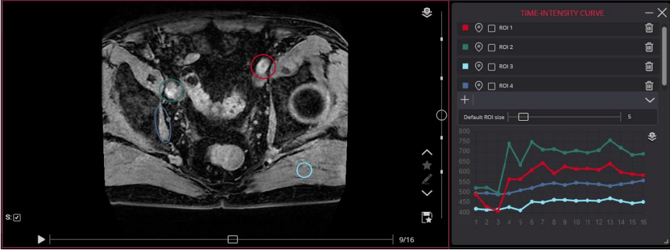Time-Intensity Curve measurement
This tool analyzes temporal changes in signal intensity across imaging phases, especially useful in dynamic contrast-enhanced MRI studies like oncology and cardiovascular imaging.
Performing Time-Intensity Curve (TIC)
1. Select the Imaging Series
- Begin by selecting the appropriate imaging series.
Typically, this will be a larger multiphase series obtained after the administration of contrast media.
multiphase series obtained after the administration of contrast media. - Note: Some MRI vendors may export post-contrast phases as separated series instead of a single large multiphase series. On CMRAD, you can merge these series by constructing a virtual series using the 4D Tool, which allows you to work with a single continuous dataset.
2. Preparing for Time-Intensity Curve Analysis
- Once you have selected your series, double-click to enlarge it to a 1x1 layout (optional, but recommended for better visualization).
- Navigate to the Measurement menu and select the Time Intensity Curve Tool.
3. Series Preloading
- After selecting the TIC tool, the series will automatically preload. Preloading refers to a temporary local download of the DICOM images into your browser. This process is crucial for enabling post-processing and ensuring smooth performance during the TIC analysis.
4. Performing the Analysis
- You can now select and draw multiple regions of interest (ROIs) on the images. The TIC tool will graph the intensity changes over time within these ROIs, allowing for a detailed assessment of tissue response to contrast over time.
- Real-time feedback, with the curve, is automatically updated as you adjust the ROIs or move through the different phases.

Merging Separated Dynamic Series
It is possible to create a virtual series in studies where multiple DCE phases are split across separate series, rather than combined into a single large series stack
-
Try the 4D Tools > Construct 4D "virtual" series function to select and combine series with
 the same description into a larger virtual series. The virtual series requires a full study preload and will appear as the last series in the study.
the same description into a larger virtual series. The virtual series requires a full study preload and will appear as the last series in the study.
Please note that the Time-Intensity Curve ROIs and their information are not stored.Note: This feature depends on consistent DICOM metadata and description across the separated phases and may not function in some studies with suboptimal DICOM metadata.
This tool may appear via the more options menu on smaller screens.